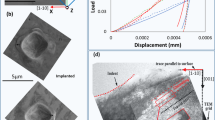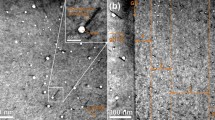Abstract
Thermocouples made from heavily doped n - and p-type silicon-germanium alloys are used in the nuclear powered thermoelectric generators which provides onboard power to the American Voyager spacecraft. The isotopic heat source is expensive and any improvement in the generators' heat energy to electrical energy conversion efficiency would save both money and weight. The possibility of reducing the thermal conductivity of thermoelectric semiconductor alloys by compacting fine grained material has been considered and various estimates have been made of the reduction in thermal conductivity with grain size. The electrical properties of hot pressed compacts of heavily doped silicon germanium alloys which possess density values dose to that of single crystal are unaffected by grain boundary scattering effects. Consequently, this method of preparation holds out a possibility of improving the ‘figure of merit’ of the thermocouple material and hence the conversion efficiency of the generator. Here the first measurements of the thermal diffusivity of fine grained hot pressed compacts of heavily doped n-type silicon germanium alloy are reported. The compacts investigated possessed grain sizes (L) in the range 10<L<25 µm, 5<L<10 µm and <5 µm. The results confirm that the lattice thermal conductivity decreases with a reduction in grain size. In the compact with L<5 µm, this reduction is ∼28% compared with ‘single crystal’ material. Within experimental error (<5%) the Seebeck coefficient and electrical resistivity do not change with grain size. This implies that the conversion efficiency of a thermoelectric generator employing silicon–germanium thermocouples would be significantly improved through the use of fine-grained thermocouple material.
This is a preview of subscription content, access via your institution
Access options
Subscribe to this journal
Receive 51 print issues and online access
$199.00 per year
only $3.90 per issue
Buy this article
- Purchase on Springer Link
- Instant access to full article PDF
Prices may be subject to local taxes which are calculated during checkout
Similar content being viewed by others
References
Bhandari, C. M. & Rowe, D. M. Contemp. Phys. 21, 219–242 (1980).
Rowe, D. M. J. appl. Phys. 7, 1843–1846 (1974).
Goldsmid, H. J. & Penn, A. W. Phys. Lett. 27 A, 523 (1968).
Suzuki, K. & Maki, M. J. appl. Phys. Jap. 16, 667 (1977).
Nasby, R. D. & Burgess, E. L. Proc. 7th IECEC, New York, 130 (1972).
Meddins, H. R. & Parrott, J. E. J. Phys. C. Solid St. Phys. 9, 1263 (1976).
Bhandari, C. M. & Rowe, D. M. J. Phys. C. Solid St. Phys. 11, 1787–1794 (1978).
Mullin, J. W. Chemy Ind. 1435–1436 (1971).
Bunce, R. W. & Rowe, D. M. J. Phys. D. Appl. Phys. 10, 941–947 (1977).
Rowe, D. M. & Savvides, N. J. Phys. D. Appl. Phys. 12, 1613–1619 (1979).
Taylor, R. J. Phys. E. Scient. Instrum. 13, 1193–1199 (1980).
Dismukes, J. P. et al. J. appl. Phys. 35, 2899–2907 (1964).
Rowe, D. M. J. Phys. D. Appl. Phys. 8, 1042–1103 (1975).
Author information
Authors and Affiliations
Rights and permissions
About this article
Cite this article
Rowe, D., Shukla, V. & Savvides, N. Phonon scattering at grain boundaries in heavily doped fine-grained silicon–germanium alloys. Nature 290, 765–766 (1981). https://doi.org/10.1038/290765a0
Received:
Accepted:
Issue Date:
DOI: https://doi.org/10.1038/290765a0
This article is cited by
-
A Review of Lamellar Eutectic Morphologies for Enhancing Thermoelectric and Mechanical Performance of Thermoelectric Materials
Journal of the Indian Institute of Science (2022)
-
Intrinsic nanostructure induced ultralow thermal conductivity yields enhanced thermoelectric performance in Zintl phase Eu2ZnSb2
Nature Communications (2021)
-
Melt-Spun SiGe Nano-Alloys: Microstructural Engineering Towards High Thermoelectric Efficiency
Journal of Electronic Materials (2021)
-
The influential mechanism of Ti doping on thermoelectric properties of Bi0.5Sb1.5Te3 alloy
Journal of Materials Science: Materials in Electronics (2021)
-
Low thermal conductivity and enhanced Seebeck coefficient in Antimony and Selenium co-doped PbTe Nanopowders
Indian Journal of Physics (2021)
Comments
By submitting a comment you agree to abide by our Terms and Community Guidelines. If you find something abusive or that does not comply with our terms or guidelines please flag it as inappropriate.



